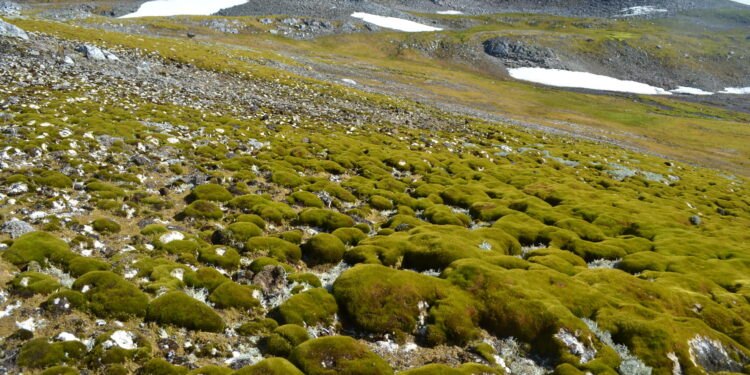Ardley Island. Credit: Dan Charman
Vegetation cover on the Antarctic Peninsula has increased more than 10-fold over the past four decades, new research shows.
The Antarctic Peninsula, like many polar regions, is warming faster than the global average, with extreme heat events in Antarctica becoming more frequent.
The new study, carried out by the universities of Exeter and Hertfordshire and the British Antarctic Survey, used satellite data to assess the extent to which the Antarctic Peninsula has become ‘green’ in response to climate change.
It was found that the area of vegetation cover on the peninsula increased from less than one square kilometer in 1986 to almost 12 square kilometers in 2021.
Published in the journal Natural geosciencesThe study also found that this greening trend has accelerated by more than 30% in recent years (2016-2021) compared to the full study period (1986-2021), an expansion of more of 400,000 square meters per year during this period. The paper is titled “Satellite evidence of sustained greening of the Antarctic Peninsula.”
In a previous study, which examined cores taken from moss-dominated ecosystems on the Antarctic Peninsula, the team found evidence that plant growth rates had increased significantly in recent decades.
This new study uses satellite imagery to confirm that a widespread greening trend across the Antarctic Peninsula is underway and accelerating.
Green Island. Credit: Matt Amesbury
“The plants we find on the Antarctic Peninsula, mainly mosses, grow in the harshest conditions on Earth,” said Dr Thomas Roland, from the University of Exeter.
“The landscape is still almost entirely dominated by snow, ice and rock, with only a tiny fraction colonized by plant life.
“But this tiny fraction has increased dramatically, showing that even this vast and isolated ‘wilderness’ is affected by anthropogenic climate change.”
Dr Olly Bartlett, from the University of Hertfordshire, added: “As these ecosystems become established and the climate continues to warm, it is likely that the extent of greening will increase.
“Antarctica’s soil is mostly poor to non-existent, but this increase in plant life will add organic matter and make soil formation easier, potentially paving the way for other plants to grow.
“This increases the risk of the arrival of non-native and invasive species, possibly carried by ecotourists, scientists or other visitors to the continent.”
Norsel Point. Credit: Dan Charman
The researchers highlight the urgent need for further research to establish the specific climatic and environmental mechanisms driving the “greening” trend.
“The sensitivity of the Antarctic Peninsula’s vegetation to climate change is now clear and, in the event of future anthropogenic warming, we could see fundamental changes in the biology and landscape of this iconic and vulnerable region,” said Dr. Roland.
He added: “Our findings raise serious concerns about the environmental future of the Antarctic Peninsula and the continent as a whole. In order to protect Antarctica, we must understand these changes and identify precisely what is causing them.”
Researchers are currently studying how recently deglaciated (ice-free) landscapes are colonized by plants and how this process might unfold in the future.
More information:
Natural geosciences (2024). DOI: 10.1038/s41561-024-01564-5
Provided by the University of Exeter
Quote: Antarctica ‘greening’ at spectacular rate, satellite data shows (October 4, 2024) retrieved October 4, 2024 from
This document is subject to copyright. Except for fair use for private study or research purposes, no part may be reproduced without written permission. The content is provided for informational purposes only.



